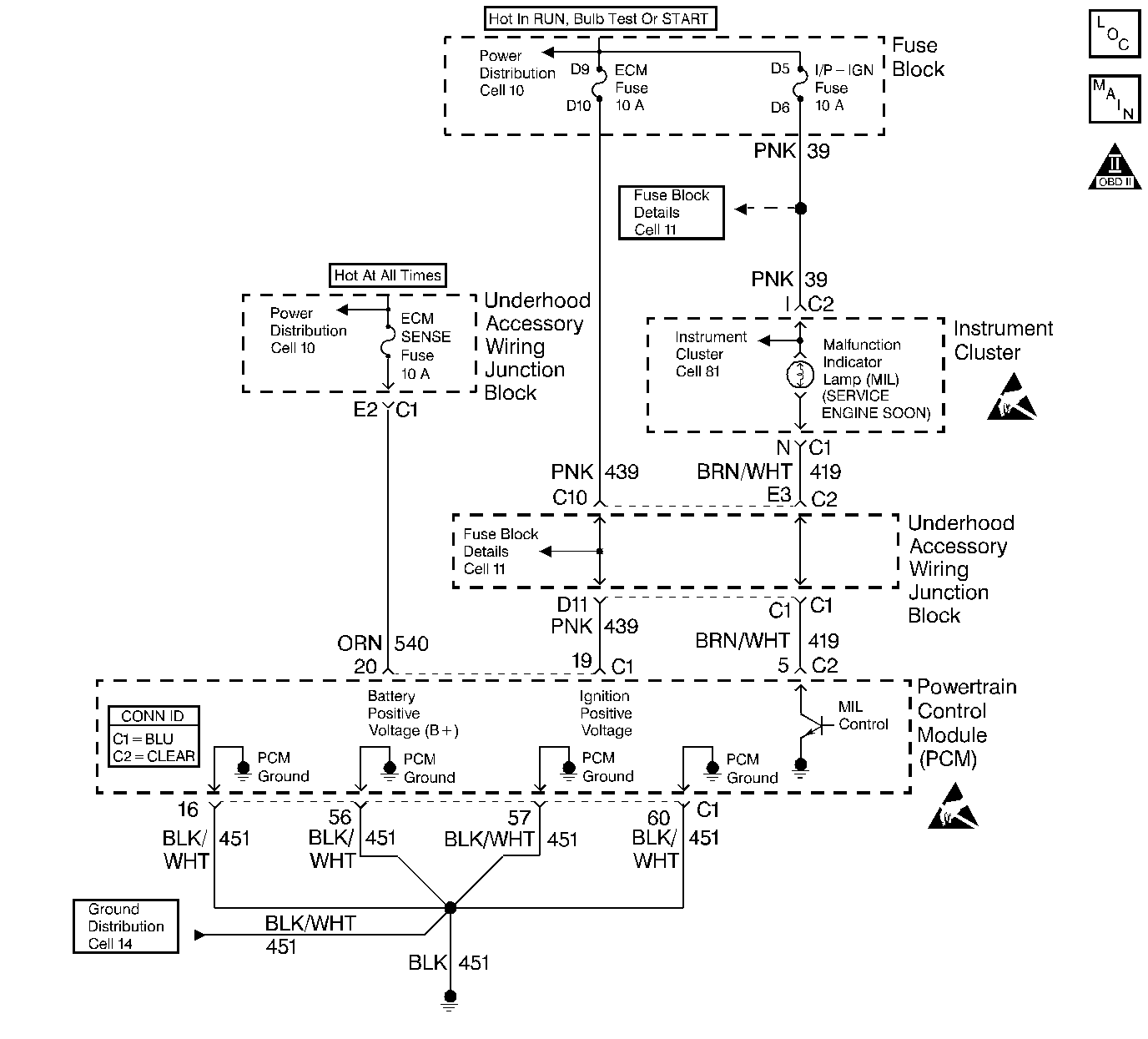
Circuit Description
Powertrain On Board Diagnostic (OBD) System Check must be the starting point for any driveability complaint diagnosis. Before using this procedure, you should perform a careful visual/physical check of the PCM and engine grounds for being clean and tight. Powertrain On Board Diagnostic (OBD) System Check is an organized approach to identifying a problem created by an electronic engine control system malfunction. No MIL with the key ON, engine not running and DTC P0650 set suggests an open in the MIL driver circuit.
Diagnostic Aids
An intermittent may be caused by a poor connection, rubbed through wire insulation or a wire broken inside the insulation. Check for the following items:
Important: : Remove any debris from the connector surfaces before servicing a component. Inspect the connector gaskets when diagnosing or replacing a component. Ensure that the gaskets are installed correctly. The gaskets prevent contaminate intrusion.
| • | Poor terminal connection. |
| Inspect the harness connectors for backed out terminals, improper mating, broken locks, improperly formed or damaged terminals, and faulty terminal to wire connection. Use a corresponding mating terminal to test for proper tension. Refer to Intermittents and Poor Connections Diagnosis , and Connector Repairs Wiring Systems. |
| • | Damaged harness. |
| Inspect the wiring harness for damage. If the harness appears to be OK, observe the sensor display on the scan tool while moving connectors and wiring harnesses related to the sensor. A change in the sensor display may indicate the location of the fault. Refer to Wiring Repairs in Wiring Systems. |
| • | Inspect the PCM and the engine grounds for clean and secure connections. |
If the DTC is determined to be intermittent, reviewing the Fail Records can be useful in determining when the DTC was last set.
Test Description
The numbers below refer to the step numbers on the Diagnostic Table:
-
A no MIL condition accompanied by a no start condition suggests a faulty PCM ignition feed or battery feed circuit.
-
Using a test lamp connected to battery positive voltage, probe each of the PCM ground terminals to ensure that a good ground is present. Refer to PCM Terminal End View for terminal locations of the PCM ground circuits.
-
This vehicle is equipped with a PCM which utilizes an Electrically Erasable Programmable Read Only Memory (EEPROM). When the PCM is being replaced, the new PCM must be programmed. Refer to Powertrain Control Module Replacement/Programming .
Step | Action | Value(s) | Yes | No |
|---|---|---|---|---|
1 | Was the Powertrain on Board Diagnostic System Check performed? | -- | ||
Attempt to start the engine. Does the engine start? | -- | |||
3 | Check the fuse for the instrument cluster ignition feed circuit. Is the fuse OK? | -- | ||
4 |
Is the with a J 35616-200 test lamp on? | -- | ||
5 |
Is the MIL on? | -- | ||
6 | Check the PCM ignition feed and battery feed fuses. Are both of the fuses OK? | -- | ||
7 |
Is the J 35616-200 test lamp on? | -- | ||
8 | Probe the battery feed circuit at the PCM harness connector with a J 35616-200 test lamp to ground. Is the test lamp on? | -- | ||
Was a problem found? | -- | |||
10 |
Was a problem found? | -- | ||
11 |
Was a problem found? | -- | ||
12 | Repair open in the ignition feed circuit to the instrument panel indicators. Refer to Wiring Repairs . Is the action complete? | -- | -- | |
13 | Locate and repair open in PCM battery feed circuit or PCM ignition feed circuit as necessary. Refer to Wiring Repairs Is the action complete? | -- | -- | |
14 | Locate and repair short to ground in PCM ignition feed circuit or PCM battery feed circuit as necessary. Refer to Wiring Repairs . Is the action complete? | -- | -- | |
15 | Locate and repair short to ground in the instrument panel indicators ignition feed circuit. Refer to Wiring Repairs . Is the action complete? | -- | -- | |
Replace the PCM. Important: : Replacement PCM must be programmed. Refer to Powertrain Control Module Replacement/Programming . Is the action complete? | -- | -- | ||
17 |
Was a problem found? | -- |
